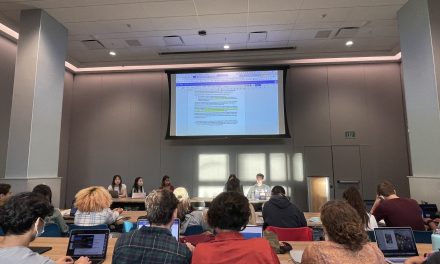Emory Libraries’ Digital Scholarship Commons (DiSC) completed their collection and visualization of over 10 million tweets from the Occupy Wall Street (OWS) movement, according to a Sept. 21 University press release. The collection includes topic-based charts, word clouds and heat maps on the first anniversary of the protest.
The archive, which began in October of 2011, documents what project coordinators feel is significant and new research territory – the relationship between historical events and the social media that chronicles them.
Researchers hope that their venture, the Tweeting #OWS project, will provide an aggregate view of time, place and networks regarding the movement showcasing a unique understanding of OWS.
According to the press release, the DiSC graduate fellows initiated the enormous undertaking with multiple questions in mind. They wanted to explore how geography could play a role in the distribution of tweets, as well as their subjects.
They also wanted to show how would current events were reflected and addressed by OWS tweets and those who are interested in the movement. In addition, they hoped to measure different groups used the OWS hashtag, and how critics and protestors networked using the form of online social media.
Emory Libraries’ Software Engineering Manager Scott Turnbull began the massive project by writing a piece of software named “Twap” (short for Twitter Trap) that essentially gathers tweets that fit specific descriptions, according to the report.
“Twitter does not allow users to go back and download large quantities of tweets; it does archive but it does not allow free, public access to that archive,” explains Stewart Varner, DiSC coordinator in the report. “The public life of a tweet is finite; after a while it is not possible to retrieve them.”
From there, the conceptualization of the website and the visualizations themselves were created by three graduate fellows in DiSC – Moya Bailey, Sarita Alami and Katie Rawson.
The images utilize the 31,825 geo-located tweets to create a display of the location and volume of tweets in New York and the United States, a graph portraying the correlation between temperature and #OWS tweets and three charts that focus on political hashtags, law enforcement terms and request terms, according to the project’s website.
“Reading through these tweets was a fascinating snapshot of the social media activity around and within Occupy Wall Street and harvesting them digitally allowed us figure out what subjects and ideas popped up most regularly,” Alami said in the press release.
Alami created the animated heat map of New York City by plotting the geographical location and date of each tweet, producing “a fascinating portrait of the Occupy movement.”
She highlighted a particular spike in Twitter activity during November 2011 from Brooklyn Bridge protesters engaged in the OWS events – who she calls the “center of the movement” – after police coerce them to clear Zuccotti Park.
The maps also expose when certain cities contributed to the national discourse.
Cities like Oakland and Chicago continuously participated to the discussion, while others, like Denver, fluctuate their involvement over time.
For future work, according to the press release, the researchers hope to increase their sample of tweets to answer further questions.
They hope to see if people who have decided to disclose their locations on Twitter have different discourse strategies or topics than people who don’t. They also plan to examine other locating factors to discover their affects on tweets and event organization via Twitter.
– By Karishma Mehrotra
The Emory Wheel was founded in 1919 and is currently the only independent, student-run newspaper of Emory University. The Wheel publishes weekly on Wednesdays during the academic year, except during University holidays and scheduled publication intermissions.
The Wheel is financially and editorially independent from the University. All of its content is generated by the Wheel’s more than 100 student staff members and contributing writers, and its printing costs are covered by profits from self-generated advertising sales.





